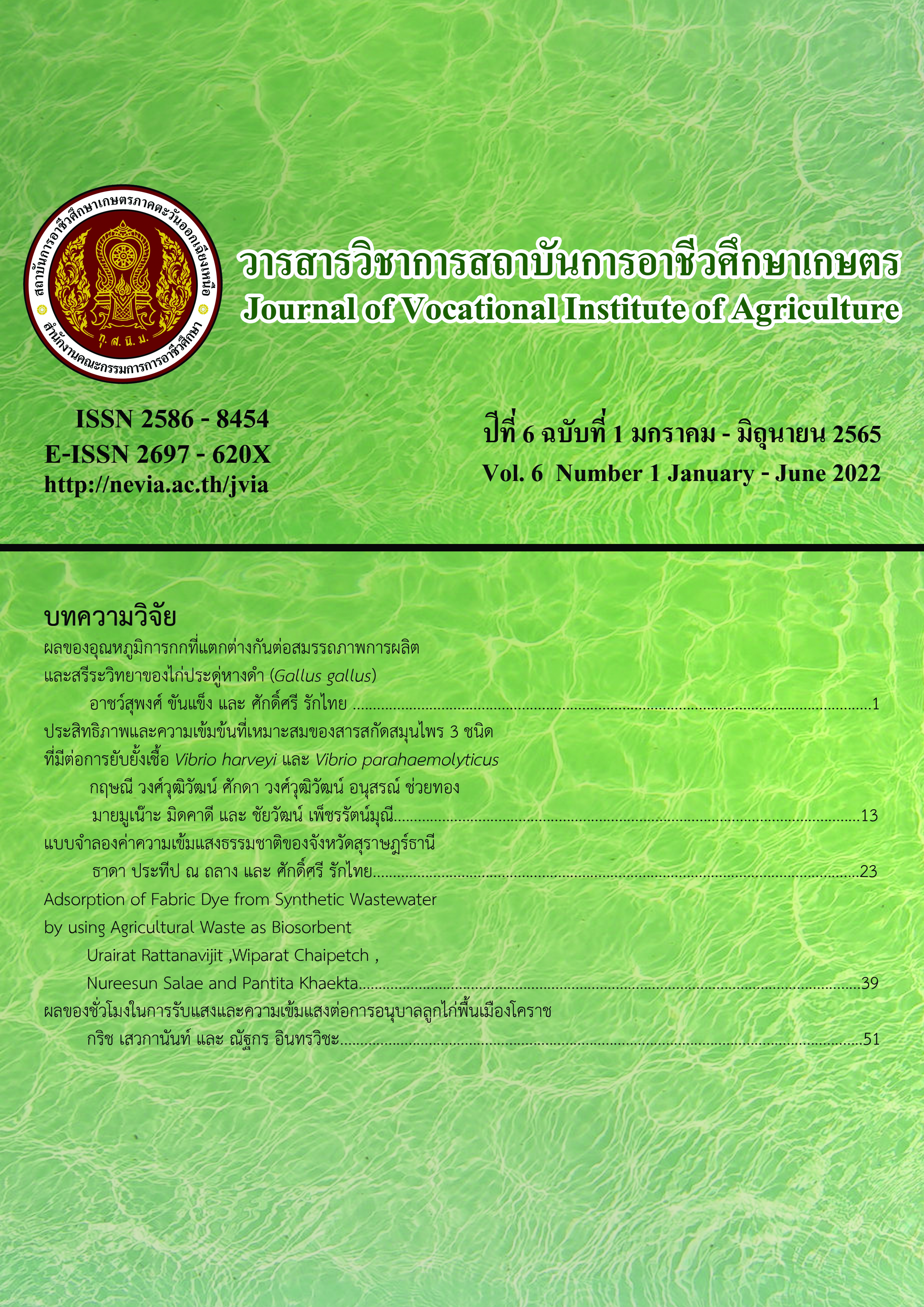Efficiency of Three Extracted Herbs on Inhibition of Vibrio harveyi and Vibrio parahaemolyticus
Main Article Content
Abstract
Vibrio harveyi and Vibrio parahaemolyticus have been the most common group of pathogenic bacteria affecting shrimp farming industry in Thailand. The use of antibiotics, as a solution, could result in antibiotic residues in aquaculture products. This study aimed to determine the minimum inhibitory concentration (MIC) and compare inhibition efficiency of three extracted herbs on V. harveyi and V. parahaemolyticus using agar well diffusion method. There were five treatments with three replications including Tropical Almond, Guava and The Creat leaf extracts diluted in 95 % methanol at 50, 25, 12.5 and 6.25 % concentration as well as distilled water and oxytetracyclin as negative and positive control respectively.
The study results showed the same MIC values (6.25 %) amomg treatments. Besides, the results in efficiency comparison found that Tropical Almond (13.25±0.55 มม.) and Guava extracts (13.50±1.58 มม.) showed the significant higher inhibition efficiency on V. harveyi than The Creat extract at 50 % concentration (P<0.05). Moreover, Tropical Almond showed the significant highest inhibition efficiency (12.55±2.68 มม.) on V. parahaemolyticus at 25 % concentration (P<0.05).
The results indicated that both extracted herbs; Tropical Almond and Guava could be antibiotic substitutes for V. harveyi and V. parahaemolyticus inhibition, even though zone of inhibition found smaller than oxytetracyclin, because of decrease in both production cost and residues
Article Details

This work is licensed under a Creative Commons Attribution-NonCommercial-NoDerivatives 4.0 International License.
The content and information in articles published in the Journal of Vocational Education in Agriculture are the opinions and responsibility of the article's author. The journal editors do not need to agree or share any responsibility.
Articles, information, content, etc. that are published in the Journal of Vocational Education in Agriculture are copyrighted by the Journal of Vocational Education in Agriculture. If any person or organization wishes to publish all or any part of it or to do anything. Only prior written permission from the Journal of Vocational Education in Agriculture is required.
References
กรมประมง. (2564). การค้าสินค้าประมงของไทย. เข้าถึงได้จาก https://www.fisheries.go.th/ strategytradestat/images/pdf/monthly/2562/june62.pdf
แก้วตา ลิ้มเฮง และคณะ. (2559). ผลของสารสกัดกระเทียมต่อการยับยั้งเชื้อ Vibrio parahaemolyticus และ Vibrio harveyi. วารสารแก่นเกษตร, 44(ฉบับพิเศษ 1), 650-655.
ศูนย์วิจัยและพัฒนาการเพาะเลี้ยงสัตว์น้ำชายฝั่งสงขลา. (2564). โรค EMS ในกุ้ง. เข้าถึงได้จาก http://www.nicaonline.com/web/index.php/2016-08-30-02-19-31/2016-08-30-14-14-19/ 838-ems.
ศูนย์วิจัยและพัฒนาการเพาะเลี้ยงสัตว์น้ำชายฝั่งสงขลา. 2564. วิบริโอ (Vibrio ssp.) แบคทีเรียก่อโรคในการเลี้ยงกุ้ง. เข้าถึงได้จาก https://www4.fisheries.go.th/local/index.php/main/ view_blog/ 1411/107692
Graslund, S., et al. (2003). A field survey of chemicals and biological products used in shrimp farming. Marine Pollution Bullatin, 46(1), 81-90.
คณะแพทยศาสตร์โรงพยาบาลรามาธิบดี. (2564). สมุนไพร. เข้าถึงได้จาก https://med.mahidol.ac.th/ poisoncenter/th/pois-cov/Herbal
องค์การเภสัชกรรม. (2559). สรรพคุณทางยา. เข้าถึงได้จาก www.gpo.or.th/herbal.
Reverter, M., et al. (2014). Use of plant extracts in fish aquaculture as an alternative to chemotherapy: current status and future perspectives. Aquaculture, 433, 50-61.
ชัยวุฒิ สุดทองคง และคณะ. (2550). ปรสิตและปริมาณแบคทีเรีย Vibrio spp. ในกุ้งขาวแวนาไม Penaeus vannamei ที่เลี้ยงในบ่อดิน. ใน การประชุมทางวิชาการของมหาวิทยาลัยเกษตรศาสตร์ครั้งที่ 45 (น. 280 - 292). กรุงเทพฯ: มหาวิทยาลัยเกษตรศาสตร์.
ประสาทพร บริสุทธิ์เพ็ชร และคณะ. (2551). การทดสอบฤทธิ์ต้านเชื้อของสมุนไพรในห้องปฏิบัติการ. ใน การประชุมวิชาการสัตวแพทย์ศาสตร์ มข. ครั้งที่ 9 (น. 91 - 101). ขอนแก่น: มหาวิทยาลัยขอนแก่น.
เพ็ญศรี บุญตามช่วย และคณะ. (2548). ประสิทธิภาพของสารสกัดใบฝรั่งด้วยวิธีต้มต่อการยับยั้งการเจริญเติบโตของเชื้อวิบริโอในกุ้งกุลาดำ. (เอกสารวิชาการฉบับที่ 47/2548, สถาบันวิจัยสุขภาพสัตว์น้ำชายฝั่ง สํานักวิจัยและพัฒนาประมงชายฝง กรมประมง กระทรวงเกษตรและสหกรณ)
อัญชลี ธํามรงค์คงสถิต. (2552). ประสิทธิภาพของสารสกัดสมุนไพรไทยในการยับยั้งเชื้อแบคทีเรียก่อโรคในกุ้งก้ามกราม. (วิทยานิพนธ์ปริญญามหาบัณฑิต, มหาวิทยาลัยแม่โจ้).
สถาพร ดิเรกบุษราคม และคณะ. (2541). เปรียบเทียบประสิทธิภาพของสารสกัดจากใบฝรั่งและอ็อกซีเตตร้าซัยคลิน ในการกำจัดแบคทีเรียเรืองแสงในกุ้งกุลาดำ. ใน การประชุมทางวิชาการของมหาวิทยาลัยเกษตรศาสตร์ครั้งที่ 36 (น. 112). กรุงเทพฯ: มหาวิทยาลัยเกษตรศาสตร์.

